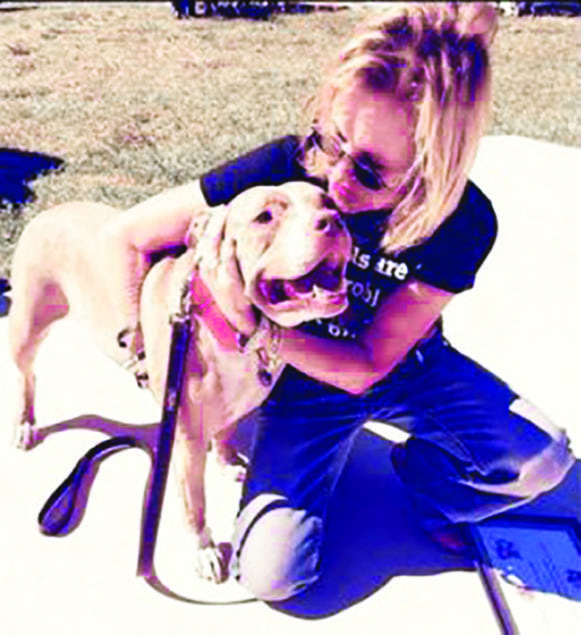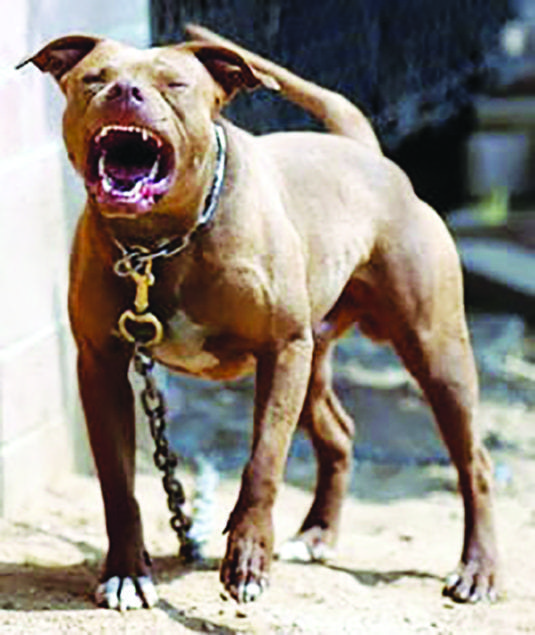Just one day before it was to be heard and voted on by the Miami-Dade Board of County Commissioners, the proposed ordinance to repeal the longstanding ban on pit bulls was pulled from the agenda. Its sponsors, District 5 Commissioner Bruno A. Barreiro and District 4 Commissioner Sally A. Heyman, cited lack of support for the ordinance as the reason for cancelling the hearing.
The ordinance almost failed outright when the board voted 5 to 7 against it on Oct. 5. But with Hurricane Matthew looming and the public unable to speak because of limited time, the hearing was deferred to Nov. 15.
Former County Commissioner Joe Gersten championed the ordinance banning pit bulls in 1989 just two months after a seven-year-old girl named Melissa Moreira had part of her face bitten off by a pit bull belonging to her neighbors. Currently, there is a $500 fine in Miami-Dade County for buying or keeping American pit bull terriers, American Staffordshire terriers, Staffordshire bull terriers or any dog that “conforms to any of these breeds’ characteristics” and court action to remove the dogs, often by euthanasia, from the county. But enforcement of the ban has sometimes been inconsistent, as in the case of Javon Dade Jr., age four, who was mauled to death in 2014 by multiple pit bulls illegally kept by his father. In that instance, the Miami-Dade Department of Children and Families failed to notify Animal Services of the dogs’ presence despite multiple visits to the household.
More than four years have passed since pit bulls last had their day in court. On August 14, 2012, Miami residents voted by an approximate 2 to 1 margin (63 percent) to uphold the ban. Commissioner Barreiro credited local pit bull advocates including the South Florida Veterinary Medical Association and the Miami Coalition Against Breed Specific Legislation (MCABSL) for convincing him to reattempt repealing the ban.
“Professionals in the industry, including dog breeders, showed substantial evidence that it’s not necessarily the dog breed but the owners who have unfortunately raised some of these dogs the wrong way,” said Barreiro. “It could occur with German shepherds, Doberman pincers and other dogs who turn aggressive. I know it’s a difficult situation and emotional for some people, but I thought the evidence was compelling enough to present it before the commission.”
The argument over pit bull legalization is one of nature versus nurture. Pit bull proponents argue that the safeness and temperament of a dog depends on its owner, training and socialization. They point to studies from groups including the American Temperament Test Society and National Geographic, which give pit bulls an 87.4 percent passing temperament rate (compared to 82.3 percent for border collies and 85.4 percent for golden retrievers) and found that they exerted the least amount of bite pressure when compared with the similarly built German Shepherds and Rottweilers.
“Dogs were bred for different purposes,” said Dr. Philip K. Stoddard, FIU biological sciences professor and South Miami mayor. “There are dogs that were bred for defense and their ability to work with people. Some were bred as lap dogs. You can see it in their attitudes, builds, coats and the things they’re interested in. Bulldogs were bred for grabbing hold of bulls and you can see it in their structure; when they bite something, they tend to hang onto it. We’ve got specialized dogs and the bulldogs—whether it’s the American bulldog, the French bulldog or the pit bull—were bred as fighting dogs. When a pit bull goes after a kid, they do serious damage. When a poodle does, they don’t.”
“Unless there’s a really bad owner and a dog that’s been abused or mistreated, we never found that there were more problems with pit bulls than with any other breed,” said Carol Vega, owner of West Point K-9 Academy.
Vega says that one adverse effect of the ban is that pit bulls have been driven underground. Many of them, unless they are labeled mixed breeds, are unable to get proper vet care and training.
“They’re definitely not able to come to a facility like ours,” she said. “That’s not a good thing. All dogs need to be trained. How do we expect to solve problems by shipping them away?”
Florida is one of 20 states prohibiting discriminatory laws against specific dog breeds, but the Miami-Dade ordinance is older than the state law and therefore supersedes it. Those in favor of upholding the ban argue that it is a matter of responsibility and credit research from people like Animals24-7.org editor Merritt Clifton, whose findings, referenced in Time, suggest that pit bulls are responsible for 68 percent of dog attacks and 52 percent of dog related deaths since 1982 (despite accounting for only 6 percent of the dog population in the U.S.). PETA, the largest animal rights group in the world, and the ASPCA recognize the problems dangerous dogs pose to communities, but have more breed-neutral positions on the matter.
“The vast majority of pit bull type dogs in our communities are likely the result of random breeding, resulting in a wide range of behavior predispositions,” said Danielle Arnold, ASPCA senior manager of media and communications. “Many external factors also strongly influence their behavior, including history of social interactions, training and housing conditions. The ASPCA believes in judging pit bull type dogs by their actions and not by their DNA or physical appearance.”
Pit bull advocates insist that many attacks are falsely attributed. With more than 400 breeds in existence, dogs have the greatest variation in body size and shape of any mammalian species on earth. Culprits of dog attacks have been routinely mislabeled. In 2010, the Eleventh Judicial Circuit of Florida (Appellate) ruled that the county’s policy of identifying a pit bull based on appearance alone was dependent on “subjective criteria” with “little or no peer review.” Essentially, animal control officers were deemed unqualified to identify breed and could therefore make no judgement based on looks alone.
The U.S. Humane Society—citing the opinions of the American Bar Association, American Kennel Club, American Veterinary Medical Association, American Veterinary Society on Animal Behavior, National Animal Control Association, Centers for Disease Control and others—stated that “neither science nor statistics support policies that discriminate based on breed or physical appearance alone.”
“The biggest flaw in any investigation of any type of dog bite is identifying the breed,” said Dahlia Canes, MCABSL director and founder, who is hosting the Eighth Annual Pit Nick at Amelia Earhart Park this Sunday. “The media has a lot to do with it because the minute they see anything resembling a pit bull, they categorize it as such. The misrepresentation of the breed itself has never been thoroughly investigated. Any dog—any breed—can be dangerous. Just because a dog is born a specific breed doesn’t make it so.”
The criteria by which pit bulls are identified is indeed ambiguous. Pit bulls are designated as being between thirty to sixty pounds and muscular, with glossy coats of any color and brick-shaped heads featuring square, well-pronounced jaws (“displaying strength”), wide-open nostrils and eyes set low and far apart.
“I guess there is a level of ambiguity with what a pit bull is and what is a mixed breed, but you know them when you see them,” said Gary Stein, Sun Sentinel columnist and editorial writer. “These dogs, which could be vicious, don’t belong in a congested area like South Florida. It’s why they’re legal in north and central Florida, where there’s room. Take Davie, which is horse country. People don’t have horses where I live, in Coral Springs, where the houses are one foot apart. You’ve got to take location into account. Otherwise, it’s unfair to the animals and unfair to your neighbors.”
There are currently 75 restricted or banned dog breeds across the country including the golden retriever, Great Dane, German shepherd, chow chow, bloodhound, Boston terrier and, perhaps most surprisingly, the pug, whose stockiness and short muzzle, on paper, infer similarities to the comparably more dangerous bull breeds.
“All dogs are the same and it’s about education and training,” said Vega. “If we don’t educate the public, how do we expect things to get any better? I’ve only been bitten by a dachshund. What am I going to do, fight to ban dachshunds? To me that’s like banning planes or cars because one of them crashes.”
To contact the County Commissioners, please visit www.MiamiDade.gov/Commission









Comments are closed.